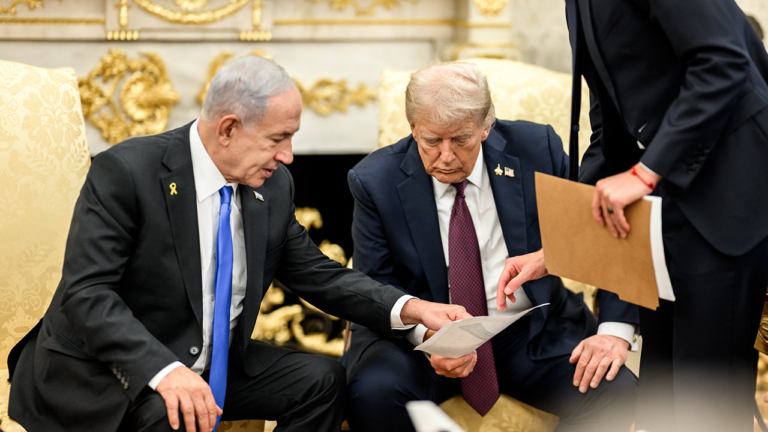
Much has been said and written about the Gaza peace plan announced by President Donald Trump and Israeli Prime Minister Benjamin Netanyahu on September 29, 2025. Many have praised it as a breakthrough that would not only end two years of fighting in Gaza but also resolve the Israeli-Palestinian conflict and even bring “eternal peace” to the Middle East. Politicians and pundits were quick to give their opinions, some of them announcing with bated breath that only Hamas’s acceptance stood between us and the promised nirvana. On October 3, Hamas announced that it had accepted parts of the plan but needed clarifications on several points, prompting President Trump to call on Israel to “immediately stop the bombing of Gaza.”
A careful reading of the proposed plan shows that it provides a vehicle for an immediate exchange of prisoners, a halt in the bombing, and Israeli permission to allow a surge of humanitarian supplies into Gaza. Those provisions lend themselves to prompt and immediate implementation. Additional provisions dealing with the governance of Gaza and the disarming of Hamas, as well as the end of the war and Israeli army withdrawal, are murkier and do not provide a clear path forward. In fact, they provide opportunities for any party to torpedo the entire process. The issue is not whether the agreement is fair or meets the needs of the different parties, but whether it can be implemented and can serve as a workable framework for implementation.
On the positive side, politicians and officials pointed out that this plan would immediately end the bombing and destruction in Gaza, and the killing of about a hundred Palestinians each day, as well as end the starvation and blockade of the Strip. The long-awaited ceasefire could become a reality. The Plan contains statements rarely heard from Netanyahu that suggest he must have been under considerable pressure to accept its provisions. The Plan states that Israel will not occupy or annex Gaza, that it will withdraw in stages, that it will allow humanitarian aid to enter, and that international organizations will be allowed to distribute that aid without interference. It also stipulates that Gazans will not be expelled but will be permitted to leave if they so choose—and that they may also return. The plan even states that “We would encourage Palestinians to stay and help build a better Gaza” and recognizes the aspirations of Palestinians to a state of their own.
On the negative side, the Plan did not seek Palestinian participation or input and was presented as an ultimatum that Hamas was required to accept within days. The alternative for Hamas would presumably be a renewed Israeli military campaign—as Netanyahu said: “we can do this the easy way or the hard way.” The imposed Plan suggests that Palestinians would be accepting defeat, not an agreement. The plan failed to address numerous Palestinian concerns, including the West Bank—although a provision in the earlier twenty-one point draft leaked to the press included a commitment by Israel not to annex West Bank lands.
The Plan was said to have the support of many Arab and Muslim leaders. However, a report by Axios stated that the Agreement originally shown to Qatar, Turkey, Egypt, and other parties, and which was shared with Hamas was then significantly amended by Netanyahu, Dermer, and Kushner to make it almost certain to be rejected by Hamas. This was evident after Netanyahu’s meeting with Trump, when the Israeli prime minister announced in a video message that he had managed to change the agreement significantly, and that the Israeli army had no intention of leaving Gaza in the foreseeable future or of allowing a Palestinian state.
The Trump Plan is not an agreement per se but purports to provide a framework for a future agreement (or agreements). The initial part of the Plan calls for Israel and Hamas to accept its terms within 3 or 4 days. Hamas’s refusal means that Trump would give Netanyahu the green light to defeat Hamas by any and all means necessary. The initial stage of the plan, involving the release of Hamas’s hostages, was very specific and had to be fulfilled within 72 hours followed by the release of Palestinian prisoners. But the plan’s remaining provisions are open to interpretation. The Plan suffers from the following deficiencies:
- It is unclear who the other parties to the agreement are. Will it be Qatar, Turkey, Jordan, Egypt, the Palestinian Authority, or some other combination? This is crucial, because the first important part of any agreement is to know who the parties are and to bind them to specific obligations and commitments or grant them specific rights and benefits. Will the other parties be required to provide guarantees for the implementation of the agreements? Will they participate in the mechanisms for security or governance of Gaza after the withdrawal of Israeli forces?
- It is not stated who will select the technocratic, apolitical Palestinian Committee charged with governing daily affairs in Gaza. Besides the provision that they must not be members of Hamas, the criteria and mechanism for their selection and appointment are unclear. Reports suggest that different families are being contacted to seek their views and suggestions for candidates for these positions.
- It is unclear who will select or announce the members of “the Board of Peace” which apparently will have ultimate authority in governing the Gaza Strip.
- The reform program for the Palestinian Authority is likely to be controversial. While the Plan refers to “various proposals, including Trump’s peace plan of 2020 and the Saudi French Proposal,” these documents are often contradictory and do not specify what is required of the Palestinian Authority or who will determine whether the PA has reformed sufficiently to meet the requirements. This provision is important since the staged withdrawals of Israeli forces from Gaza are specifically linked to PA reform and its capacity to fulfil the responsibilities of governance and security provision after it assumes authority for the Strip. Given the fact that Netanyahu has repeatedly stated that the Palestinian Authority will not be allowed to play any part in governing Gaza, the vague requirements for successful reform provide the perfect tool to exclude the PA from governance.
- The plan fails to designate the basic law or legal principles that govern the process. Even a simple contract between two parties usually provides that the agreement is to be governed by the law of a particular state, for example. For international agreements, reference is usually made to international law and the legal principles that govern the agreement.
- The plan offers no mechanism for interpreting its provisions. This absence is a fatal flaw, as the plan itself is insufficiently clear or detailed. Even if it were more detailed, issues of interpretation will always arise. Who will decide between conflicting interpretations of the plan?
- The plan makes no provision for resolving conflicts between the parties, or for dealing with additional issues that will inevitably arise during its implementation. Will disputes be settled by arbitration, mediation, the International Court of Justice, or fiat by some superior party?
- As in past plans and agreements, the Trump Plan fails to provide penalties in case of clear breaches of its provisions. It does provide that regional parties (yet unnamed) will provide guarantees that Hamas will abide by its obligations. It is nevertheless unclear who these guarantors are and what guarantees are being provided. At the same time, the plan asks no party to guarantee that Israel will fulfill its obligations under the plan and does not specify what consequences Israel may face if it fails to fulfill its obligations. This element is particularly important considering statements by Netanyahu that the Israeli army is not going to withdraw from most of Gaza in the foreseeable future and in light of the previous actions of both Netanyahu and Trump himself in breaching various treaties and agreements. The absence of monitoring and enforcement mechanisms in the much more detailed 1993 Oslo Accords is now widely accepted as contributing to its failure to deliver a comprehensive peace. The initial January 15, 2025, ceasefire agreement between Hamas and Israel contained detailed provisions for three stages, but after the first stage Israel ended that agreement and resumed the bombing and blockade of Gaza after Hamas handed over many of the hostages it was holding. A similar fate would seem to await this agreement.
- Article 15 states that a “deconfliction mechanism will be agreed upon by the parties.” Again, there are no guidelines for the agreement, no process for reaching it, and no thought as to what would happen if an agreement cannot be reached.
- Article 16 states that Israel will withdraw based on “standards, milestones, and timeframes linked to demilitarization that will be agreed upon between the IDF, the International Security Force (ISF), the guarantors, and the United States.” The guarantors have not been named, and the ISF has not yet been formed. This provision alone effectively gives Israel veto power over withdrawal, which may never in fact occur. The provision also states that the objective of the guidelines for the withdrawal is to ensure a secure Gaza that no longer poses a threat to Israel, Egypt, or its citizens. The reference to Gaza’s citizens provides an opportunity to interfere—or to delay withdrawal—based not only on perceived threats to Israel, but also on perceived threats to Gaza’s citizens which may presumably come from Hamas or other parties. This loophole would provide the legal basis for undermining any Palestinian Authority (or any local authority) or a pretext for future interference in Palestinian affairs.
In summary, the Plan provides for an initial pause in hostilities and the exchange of prisoners and hostages but lacks the mechanisms necessary to ensure its own implementation. Given the mistrust between the parties, and the history of breaches and violations of agreements, it barely warrants labeling the plan a ceasefire agreement. Trump’s proposal certainly does not merit the title of a Plan for ending the conflict and ushering in a new era of peace and prosperity for the people of Gaza and the region.
The views expressed in this publication are the author’s own and do not necessarily reflect the position of Arab Center Washington DC, its staff, or its Board of Directors.
Featured image credit:Flickr/The White House

